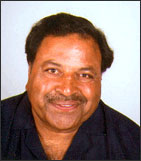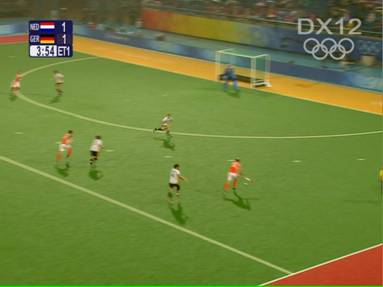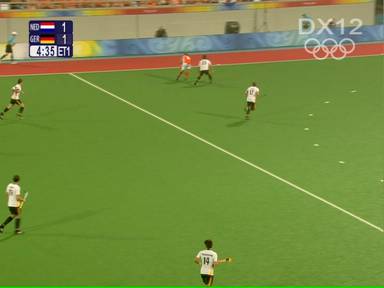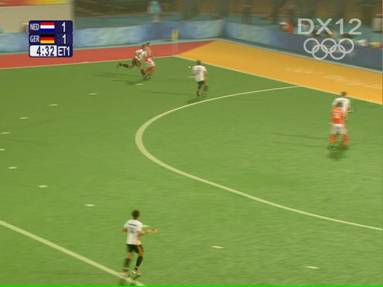Ball Positioning
During the Run of Play

For more coaching information, visit www.coachshiv.com
| January | February | March |
|
April | May | June |
|  |
|||||
| July | August | September | October | November | December | |
![]()
INTRODUCTION
Ball positioning during the run of play is a subject that has not been clearly understood, even by the very best coaches and athletes. Ball positioning for a player on the move depends on a number of factors, including:
Poor ball positioning impacts the effectiveness of individual players, and the team as a whole, even at the highest level of the game.
No wonder Paul Litjens, the Dutch superstar of the 70s, had the following to say after observing the 2004 Athens Olympic Games: "Of course players are much faster and fitter nowadays, but they are not so clever on the pitch. It's my opinion that players all do the same things at the same frantic speed, and seem totally unaware as to where their teammates are."
SCHOOLS OF THOUGHT
There are 2 schools of thoughts when it comes to ball positioning:
Protect the Ball
When protecting the ball on the run, the ball is kept on the right, left or centre of one's body, with the body placed in between the ball and the opponent to shield the ball.
The removal of the Obstruction rule in the early 90s also facilitated this strategy. However, if this is used more than necessary, it becomes self-hurting and self-defeating for the players.
Expose the Ball
The other school of thought is to expose the ball, while keeping it in the front of the body. That way, the ball carrier can have a clear view of the field, the opponents' positions and the teammates' positions, giving the player more options to effectively dispose the ball.
In addition, such a strategy enables the player to entice the opposing player to take action and commit too early, enabling the player to bypass the opponent.
WHICH STYLE TO USE?
My preference is to go with the second school of thought, as it is more advantageous and rewarding than protecting the ball. As the saying goes, the higher the risk, the higher the reward.
Of course, we should use caution and common sense when using this approach. There are certain game situations, especially in the deep defense, which will not facilitate keeping the ball in the front and exposed.
In the modern game, many players and coaches believe in the philosophy of one style fits all. The simple point is one style does NOT fit all. Every position and zone of the field has an appropriate style to maximize one's effectiveness and outmanoeuver the opponent.
The great Indian and Pakistani players of the past century clearly understood this concept and employed it effectively in the given game situations. The current and former Australian players can also be included in this category, especially the highly successful womens teams of the 90s, coached by Ric Charlesworth.
Unfortunately, the majority of the present Indian hockey players do not understand this concept, and thus have not been able to be as effective as they can be and should be.
EXAMPLES
In order to bring awareness and develop better understanding of this concept, from one specific position and zone, let's take the example of a right-winger or left-winger approaching a deep defender, in the opponent's 25-yard zone.
Where should the winger keep the ball in relation to his/her body and why? When one does not do so, what are the consequences?
| Optimal Stance (Right Winger) |
The right-winger should keep the ball in front of him, in a straight line to his nose, in the center of the body while having the stick at a 45 degree angle.
The stick angle can be kept less slanting. The ball can be kept in the centre, giving the right-winger an option to go either right or left.
Furthermore, this stance plants a seed of doubt in the mind of the approaching defender, who will be unsure which way the winger may go.
This stance also provides the forward a good view to scan the field for making a quality pass.
| Scenario 1: Optimal Stance (Right Winger) |
 |
| Ronnie Jagday (Author's son), 2004 Athens Olympics |
| 25-Yard Zone : Attacking from the Right |
In the photographs below, Teun de Nooijer of Netherlands is running with the ball and approaching the German defender, while having the ball slightly to his right side, in the role of a right-winger, on the right side of the opponents' defensive zone.
Teun's objectives are to eliminate the approaching German defender, or to make a defence-splitting pass. However, keeping the ball slightly to his right, while allowing him to protect the ball, diminished his options to a certain degree.
This move ended in Teun not being able to pass the ball to his leading forwards. It resulted in a cross that was not received by his teammates, and ended up as a wasted move.
| Scenario 2: Right-Winger Approaching a Defender in the 25-Yard Zone | |
 |
 |
| Teun de Nooijer, 2008 Beijing Olympics semi-final, Netherlands vs. Germany | |
| 25-Yard Zone : Attacking from the Left |
In this example, the Dutch left-winger is receiving the ball, with his body in between the ball and the marking German defender.
While the winger was successful in protecting the ball, at the same time he had blocked his view of the attacking goal, positions of his teammates, and above all, the positional play of his opponents.
This makes it hard, if not impossible, to exploit the opponents' defence. The final outcome of this move was the ball crossing the goalline in a fruitless effort.
| Scenario 3: Receiving a Pass in the 25-Yard Zone | |
 |
 |
| 2008 Beijing Olympics semi-final, Netherlands vs. Germany | |
CONCLUSION
The first step is awareness - to recognise what we are doing incorrectly. The second step is to decide whether we want to maintain status quo, or make a change for the better. The third step is execution of the intent - making the positive change to achieve optimal performance.
In next month's article, we will talk about receiving the ball, as a forward.
![]()